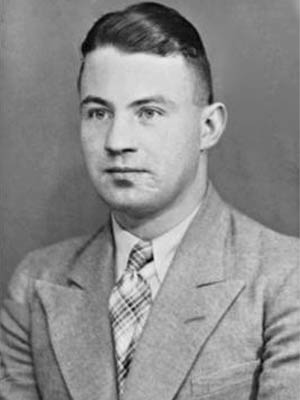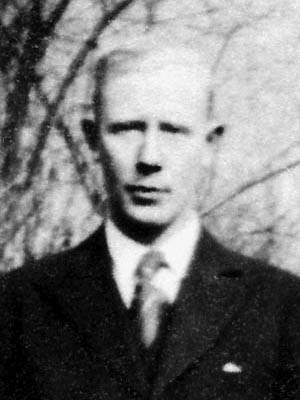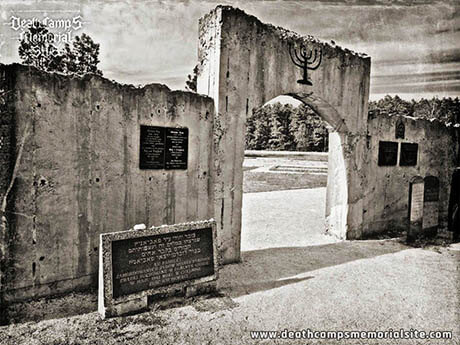Kulmhof - German extermination camp
Period of operation: XII 1941- IV 1943 and VI 1944 - I 1945
Place / City: Chełmno nad Nerem (DE - Kulmhof)
Number of victims: around 200 000 *
* - due to the very small number of victims who survived and testified after the war, as well as due to damaged documentation, and the activities of Sonderkommando 1005 which blurred traces of the crime, the estimated number of victims is about 200,000, including about 4,000 Roma and countless Poles, children from the Zamość region, children from Lidice, and prisoners of the Red Army. The investigation conducted after the war by judge Władysław Bednarz from the District Court in Łódź allowed to estimate the number of victims at 350,000. The lowest, 152,000 victims, was found at the Bonn trial in the 1960s. The most likely number is around 200,000 murdered.
Commandants of the Kulmhof extermination camp
Herbert Lange

Hans Johann Bothmann

The palace complex in Kulmhof am Nehr (Chełmno on the Ner), which was very much like the Tötungsanstalt Pirna-Sonnenstein (Sonnenstein Euthanasia Center) where mass murders were carried out as part of Operation T4, was selected as the site of the first German center for the mass extermination of Jews. Chełmno nad Nerem became the main place of mass extermination of the Jewish population from the Reichsgau Wartheland and prisoners of the Litzmannstadt ghetto. It was the only extermination camp which functioned in two periods, i.e. 1941-1943 and 1944-1945.
The construction of the camp began in the fall of 1941 under the command of Herbert Lange, who, as a participant in the T4 operation, already had experience in mass murders using gas. He also became the first commandant of the camp.
The first period of operation dates from December 8, 1941 to April 11, 1943. Extermination was carried out in cars - mobile gas chambers, using exhaust fumes. After arriving in the village of Kulmhof (Chełmno na Nerem), the prisoners, under the guise of bathing and disinfecting, were directed to the undressing room in the palace basement before their further journey. The naked victims were beaten and forced to go down a narrow corridor. At the end, there was the entrance to the gas car to which the exhaust pipe outlet was connected. Thus, exhaust gases filled the chamber of the car. In an airtight interior, death occurred within 10-20 minutes.
Then, the trucks went to the Rzuchowski Forest, 4 kilometers away, where a special commando of prisoners named Waldkommando unloaded and buried the bodies in mass graves, 60 to 230m long. At the same time, the second special commando - the Hauskommando - cleaned the undressing room, sorted clothes, and collected valuable items, which were then transported deep into the Reich.
First, Jews from the surrounding ghettos were murdered: Koło, Kowale Pańskie, Kłodawa, and Izbica Kujawska. In January 1942, deportations of Roma began from the local camp in Litzmannstadt (Ziegeunerlager in Łódź) established in the fall of 1941, and then Jews from the Łódź ghetto and Jews from Germany, Czech Republic and Austria, who were settled in Łódź in the fall of 1941.
In March 1942, Herbert Lange was transferred to the RSHA to work in the Kripo, and was succeeded by Hans Bothmann. In the summer of 1942, extermination was briefly halted because of an epidemiological threat. The removal of the bodies from the graves and burning them in the field crematoria began. Paul Blobelappeared in Kulmhof with hisSonderkomando 1005. Their task was to obliterate the evidence of mass murders. In March 1943, a decision was made to liquidate the camp. On April 11, the SS men left the camp, blowing up the crematoria, and the day before, the palace used as a "changing room". The camp crew under the command of Hans Bothmann was sent to Yugoslavia.
In March 1944, Hans Bothmann returned to Chełmno with his men, preparing the camp infrastructure for mass deportations and extermination of the Jewish population from the Reichsgau Wartheland. In the period from June 23 to July 14, 1944, ten transports of Jews came from Litzmannstadt (Łódź). At that time, 7,196 inhabitants of the Litzmannstadt ghetto were murdered. Then, the extermination action was stopped. The extermination was carried out within the Rzuchowski Forest, where barracks were built and the area was adapted to receive further transports of victims.
Part of the Sonderkommando staff and a group of the last Jewish prisoners, held in a granary next to the demolished palace, remained in the village. On the night of January 17-18, 1945, during the evacuation, the SS men carried out the last execution of the 47 surviving prisoners. The prisoners were led out of the granary in fives and murdered with shots in the back of the head. Desperate prisoners, locked in a granary, rioted and managed to kill two torturers. Then, the Germans set fire to the granary with the prisoners inside. The order was given by the commandant Hans Johann Bothmann. During this action, two prisoners, i.e. Szymon Srebrnik and Mieczysław Żurawski, managed to survive.
The estimated number of victims is about 200,000, including about 4,000 Roma and countless Poles, children from the Zamość region, children from Lidice, and prisoners of the Red Army. The investigation conducted after the war by judge Władysław Bednarz from the District Court in Łódź allowed to estimate the number of victims at 350,000. The lowest, 152,000 victims, was found at the Bonn trial in the 1960s. The most likely number is around 200,000 murdered.
Fugitives and people saved from death
Little is known about the escapees from the camp. It is assumed that at least 11 prisoners escaped from the camp. However, anything more can only be said about the 7 survivors. Six people survived the war:
1. Szymon Srebrnik
2. Michał Podchlebnik
3. Abraham Rój
4. Mieczysław Żurawski
5. Jarchemiel Widawski
6. Icchak Justman
7. Jakub Grojanowski (Szlamek) - died in the German death camp in Bełżec.
Silent hearo from Chełmno
Stanisław Kaszyński was a Polish local government official and social activist during the Second Polish Republic and a long-time secretary of the Chełmno commune. He was an educated man, respected and liked by the inhabitants, but he also secretly collaborated with the Polish Underground State. Units of the Union for Armed Struggle and the Home Army (from 1942) operated in this area.
In January 1942, Kaszyński took the initiative to transfer information about the crimes committed against the Jews in the German death camp Kulmhof to the West. His letter, which was to be sent to the International Red Cross in Switzerland, was, however, intercepted by the SS. As a consequence, Stanisław Kaszyński was arrested and imprisoned. After a few days, when Kaszyński was led out under escort, he made an attempt to escape during which he was shot. It was most likely on February 2 (or 3), 1942, near the palace. Kaszyński's body was buried in an unknown place in the Rzuchowski Forest, where in 1991 a monument commemorating Stanisław Kaszyński was unveiled.
Stanisław Kaszyński's wife, Karolina, who was then pregnant, was deported to a German women's camp in Łódź, and then transferred to the Gestapo prison, where she was murdered. Stanisław and Karolina Kaszyński orphaned four children who, after their mother's arrest, were looked after by Karolina's friend, Cecylia Sońta.
What happened to the torturers:
- Herbert Lange - the first commandant of the camp died at the end of the war, during the fights for Berlin.
- Hans Bothmann - the second commandant of the camp hanged himself in April 1946, in his cell.
- Walter Piller - deputy commander, was sentenced to death by a Polish court. The sentence was carried out in 1949.
- Hermann Gielow - death car chauffeur, was sentenced to death by a Polish court. The sentence was carried out in 1951.
- Bruno Israel - gendarme, was sentenced to death by a Polish court in 1946, the sentence was changed to life imprisonment, released in 1958.
- 13 camp staff members were brought to trial in West Germany in 1962-1965. Eight of them were sentenced to imprisonment from 7 to 13 years.
- In July 2001, Henryk Mania (a prisoner from Fort VII sent to Chełmno) was sentenced to 8 years in prison for his participation in the genocide process.
Calendar of events
1941-12-08 ▪ The first mass execution of about 700 Jews who arrived a day earlier was carried out.
1941-12-17 ▪ 975 Jews from the Dąbie ghetto are transported to the Kulmhof camp - 920 people are killed immediately.
1942-01-16 ▪ Beginning of deportation of Jews from the Łódź ghetto to the Kulmhof camp.
1942-01-17 ▪ The first group of Jews from Litzmannstadt is murdered in the Kulmhof camp.
1942-08-XX ▪ Beginning of transports of the Roma to the Kulmhof camp.
1942-09-XX ▪ Deportation of Jews from the Łódź ghetto. Around 15,700 ghetto inhabitants are transported to Kulmhof.
1943-04-01 ▪ The commando left the Kulmhof camp, blowing up crematoria.
1943-04-11 ▪ SS-Sonderkommando Kulmhof leaves Chełmno and is directed to Yugoslavia as part of the Waffen SS Prinz Eugen unit.
1944-06-23 ▪ Kulmhof extermination camp resumes operations. Extermination was carried out within the Rzuchowski Forest, where barracks were built and the area was adapted to receive subsequent transports of victims.
1945-01-18 ▪ Evacuation of the Kulmhof extermination camp, during which SS men carried out the last execution of the Sonderkommando crew.
Related Articles
- Stanisław Kaszyński - The Silent Hero from Chełmno on the Ner
- Radegast Litzmannstadt Station (Łódź)
- Kulmhof - The Beginning Of Mass Extermination - December 08, 1941
- The Tombstone Lapidarium In The Rzuchowski Forest
- Kulmhof - The establishment of an extermination camp
- "Wielka Szpera" - mass deportations
- Gas chambers in Germans Death Camps
- Wolfsschanze - Wolf's Lair and concentration and extermination camps.
- Saved from hell - history of three prisoners from Kulmhof
Photo gallery
(Click or touch photo)
Museum
A monument was erected (1964) and a small museum was opened in the former extermination camp (June 17, 1990). The exhibition shows items related to the history of the area and copies of reports and post-war court documents. The granary has been restored. The Rzuchowski Forest includes a monument that represents the "wall of remembrance" with the inscription: In memory of the Jews murdered in Chełmno 1941–1945, and important places were marked, such as graves, location of gas chambers and crematoria, and a Lapidarium of Jewish tombstones.
Website: www.chelmno-muzeum.eu
